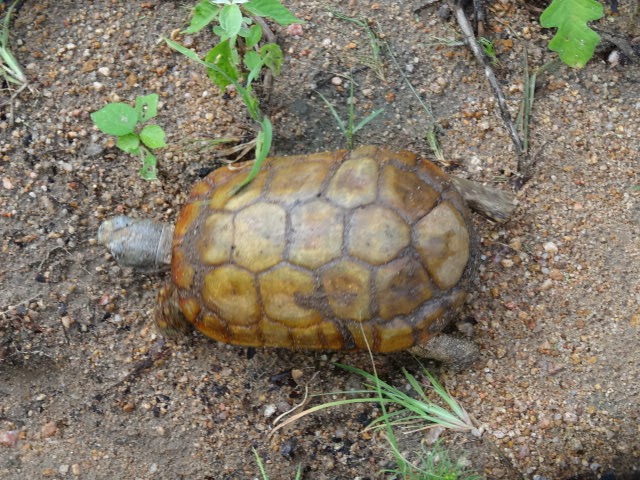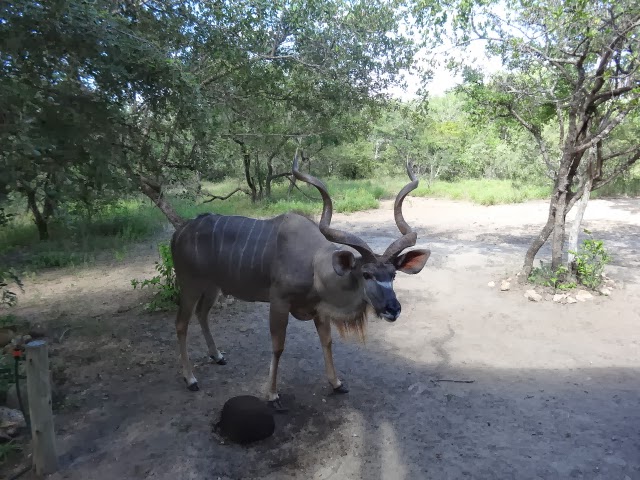 |
| Hand carved African decorator items are tastefully displayed in Khaya Umdani. |
 |
| Vegetation native to South Africa grows freely without little care or maintenance. |
 |
| There in the side yard, outside the master bedroom door, was this lovely Bird of Paradise that had bloomed since we arrived on Thursday. This morning we noticed a second bloom.
Less than 48 hours ago, we temporarily moved into this exquisite six-bedroom, five-bathroom home in Marloth Park, known as Khaya Umdami (houses are named in Africa and some other parts of the world), and instantly I fall back into my old patterns of thinking, “Shall we invite company for dinner?” and, “What shall I wear?” These are two questions that haven’t crossed my lips in a very long time.
Besides, I don’t have enough clothing left to make what I wear ever an issue. I wear what is clean and available. Style is out the window!
|
 |
When Louise and Danie renovated Khaya Umdami, this sixth bedroom was a part of the renovation. During the construction period, baby warthogs entered of their own volition and slept in the en suite bathroom’s shower at night. In the morning, they’d have to scoot them out. Thus, the name of this bedroom accessed via the veranda.
 The warthog room as all of the other five bedrooms has its own unique décor and stone en suite bathroom. Amenities include its own refrigerator as shown in the far right. In our old lives Tom often referred to my “linen napkin lifestyle” which obviously, I’ve let go since the beginning of our world travels. Not only have I let it go but I’ve found myself content with the dishtowel on my lap as we dine on the same 10 things we cook for dinner, over and over again.
|
 |
| Nope, there were no hippos visiting this room. But, at night one can hear the gurgling sounds of the hippos emanated from the nearby Crocodile River. |
 |
| Mosquito netting as shown in the hippo room is commonly placed around beds in Africa. Although, after two months in Marloth Park we’ve yet to use the netting. Keeping the bedroom door closed during the day prevents insects from entering. Plus, the bedrooms have air conditioning, which further reduces the presence of mosquitoes. I recall being concerned about mosquitoes when booking with Louise and Danie for Marloth Park. They haven’t been an issue, using a bit of repellent each day, even for me, a mosquito magnet. |
 |
| This soaking tub in the hippo room is appealing after a bush braai (fabulous food!) which includes a game drive in the late afternoon, hosted by Louise and Danie. We know from personal experience! |
My lifetime interest as a “foodie” has all but disappeared as we’ve discovered that special ingredients conducive to my way of eating become more and more difficult to find as we’ve traveled the world. A former dessert baking aficionado, I’ve since given up grains, starch, and sugar, leaving few options for desserts so we stick to nuts, nuts, and more nuts, which are prolific in Africa, some of the best in the world.
 |
| The Kingfisher room is named for the frequent sighting of the Kingfisher bird, often seen through the window of this room on a nearby tree. Our eyes are peeled in that direction. |
 |
| The Kingfisher room has a bathroom with a stone shower a few steps outside the door which may be used as its own private bath or shared with guests while mulling on the main floor. |
With planning last night’s dinner imminent, it didn’t take long for me to search the cupboards and drawers in Khaya Umdami in search of linen napkins, suddenly no longer content with a dishtowel in place of a neatly pressed linen napkin.
 |
| The well-stocked kitchen was calling me as I began searching through cabinets and drawers to enhance last night’s dinner place settings. |
 |
| The only mess in this cupboard is our stuff on the middle shelf which we brought over from the smaller house. |
 |
| The beautiful dinnerware made an attractive place setting possible for our dinner. |
 |
| This organized cupboard holds a wide array of wine and beverage glasses. |
 |
| With little access to plastic containers for over a year, this tidy cupboard held particular appeal. |
 |
| More pots, pans, and baking and cooking supplies, more than we’ve had anywhere we’ve lived since leaving the US. Look! There are even two graters! |
So, last night, we grilled the two chickens we’d brought with us on the spit of the traditional, non-braai, gas grill so readily familiar to us for a wonderful nostalgic dinner on cloth placemats with linen napkins, proper place settings and the peculiar knowledge that here in Khaya Umdami we need not even wash our own dishes, leaving them for household staff to handle the next day. How decadent!
 |
| Our simple place setting fulfilled all of my expectations for a dinner outdoors last night. |
 |
| There is was our first outdoor grilled dinner since leaving the US. None of our past vacation/holiday homes had outdoor grills that we’ve found suitable. This was a rare treat. Wrapped in foil on the side grate is the chicken gizzards and livers which I’ll eat with tonight’s repeat dinner. Tom only eats white meat and I like dark meat, making a whole chicken perfect for us. Zeff cleaned it this morning and, did all the dishes! Oh, good grief! |
 |
| This was Tom’s plate of food. Mine was identical except piled high with the various bones and dark meat parts. We’d cooked the chickens for 90 minutes, on high for the first 20 minutes, and on low for the remaining time. The chicken was moist and delicious. As usual, we had our favorite low carb, sugar-free coleslaw, a daily staple which we love. |
Soon, we’ll return to the smaller house, and once again, we’ll return to using dishtowels as a linen napkin and to my bigger concerns expressed to Tom dozens of times each day, “Did you hear something?” or, “Did you see something?” Of course, these questions revolve around our intense interest in seeing more wildlife, any wildlife actually! Pigs, striped horses, or poop rolling beetles! We love them all!
 |
| This was a first for us, a mom warthog with long brown hair. She was kneeling to eat after I tossed some pellets. Their knees are particularly calloused so they can easily kneel when eating. Their snouts make it difficult for them to eat fully standing. |
For now, as we languish in this special property, we revel in its stories, its amenities, it’s a magical way of being incorporated into the bush, its lush vegetation and, its wildlife, offering a cocoon of comfort and wonder that only Marloth Park, South Africa can offer.
 |
| A young male impala checked us out before venturing to Khaya Umdami‘s private watering hole. |
Yesterday afternoon, Danie stopped by offering that he and Louise teach us to braai on the open wood fire here at Khaya Umdami, the true South African way, a lesson we must learn before departing in 27 days. We heartily agreed with considerable enthusiasm and an abundance of appreciation for yet another amazing experience in the bush.
 |
| We held our breath waiting for him to take a drink, not to disappoint. |
Ha! It looks as if company may be coming for dinner after all! Get out the linen napkins! And, if only for a little while, take me back to my linen napkin ways!
Note Tomorrow, the unbelievable master bedroom befitting a king and queen, the “outdoor” bedroom, and more wildlife photos we’ve taken in the past few days at Khaya Umdami. Our driver, Okee Dokee, is out of town for the weekend. But, we’re so content that we have little desire to leave.






















































































































